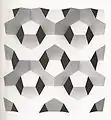Truncated order-8 triangular tiling
In geometry, the truncated order-8 triangular tiling is a semiregular tiling of the hyperbolic plane. There are two hexagons and one octagon on each vertex. It has Schläfli symbol of t{3,8}.
| Truncated order-8 triangular tiling | |
|---|---|
 Poincaré disk model of the hyperbolic plane | |
| Type | Hyperbolic uniform tiling |
| Vertex configuration | 8.6.6 |
| Schläfli symbol | t{3,8} |
| Wythoff symbol | 2 8 | 3 4 3 3 | |
| Coxeter diagram | |
| Symmetry group | [8,3], (*832) [(4,3,3)], (*433) |
| Dual | Octakis octagonal tiling |
| Properties | Vertex-transitive |
Uniform colors
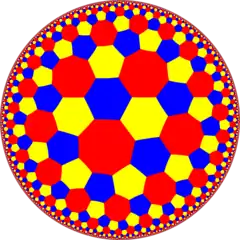 The half symmetry [1+,8,3] = [(4,3,3)] can be shown with alternating two colors of hexagons |
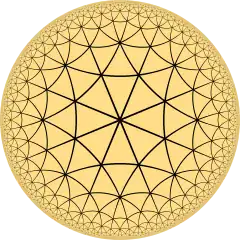 Dual tiling |
Symmetry
The dual of this tiling represents the fundamental domains of *443 symmetry. It only has one subgroup 443, replacing mirrors with gyration points.
This symmetry can be doubled to 832 symmetry by adding a bisecting mirror to the fundamental domain.
| Type | Reflectional | Rotational |
|---|---|---|
| Index | 1 | 2 |
| Diagram |  |
 |
| Coxeter (orbifold) |
[(4,3,3)] = (*433) |
[(4,3,3)]+ = (433) |
Related tilings
From a Wythoff construction there are ten hyperbolic uniform tilings that can be based from the regular octagonal tiling.
| Uniform octagonal/triangular tilings | |||||||||||||
|---|---|---|---|---|---|---|---|---|---|---|---|---|---|
| Symmetry: [8,3], (*832) | [8,3]+ (832) |
[1+,8,3] (*443) |
[8,3+] (3*4) | ||||||||||
| {8,3} | t{8,3} | r{8,3} | t{3,8} | {3,8} | rr{8,3} s2{3,8} |
tr{8,3} | sr{8,3} | h{8,3} | h2{8,3} | s{3,8} | |||
| Uniform duals | |||||||||||||
| V83 | V3.16.16 | V3.8.3.8 | V6.6.8 | V38 | V3.4.8.4 | V4.6.16 | V34.8 | V(3.4)3 | V8.6.6 | V35.4 | |||
It can also be generated from the (4 3 3) hyperbolic tilings:
| Uniform (4,3,3) tilings | |||||||||||
|---|---|---|---|---|---|---|---|---|---|---|---|
| Symmetry: [(4,3,3)], (*433) | [(4,3,3)]+, (433) | ||||||||||
 |
 |
 |
 |
 |
 |
 |
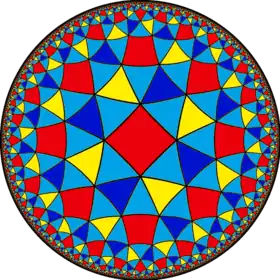 | ||||
| h{8,3} t0(4,3,3) |
r{3,8}1/2 t0,1(4,3,3) |
h{8,3} t1(4,3,3) |
h2{8,3} t1,2(4,3,3) |
{3,8}1/2 t2(4,3,3) |
h2{8,3} t0,2(4,3,3) |
t{3,8}1/2 t0,1,2(4,3,3) |
s{3,8}1/2 s(4,3,3) | ||||
| Uniform duals | |||||||||||
 |
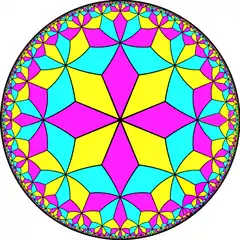 |
 |
 |
 |
 |
 |
 | ||||
| V(3.4)3 | V3.8.3.8 | V(3.4)3 | V3.6.4.6 | V(3.3)4 | V3.6.4.6 | V6.6.8 | V3.3.3.3.3.4 | ||||
This hyperbolic tiling is topologically related as a part of sequence of uniform truncated polyhedra with vertex configurations (n.6.6), and [n,3] Coxeter group symmetry.
| *n32 symmetry mutation of truncated tilings: n.6.6 | ||||||||||||
|---|---|---|---|---|---|---|---|---|---|---|---|---|
| Sym. *n42 [n,3] |
Spherical | Euclid. | Compact | Parac. | Noncompact hyperbolic | |||||||
| *232 [2,3] |
*332 [3,3] |
*432 [4,3] |
*532 [5,3] |
*632 [6,3] |
*732 [7,3] |
*832 [8,3]... |
*∞32 [∞,3] |
[12i,3] | [9i,3] | [6i,3] | ||
| Truncated figures |
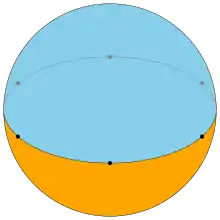 |
 |
 |
 |
 |
 |
 |
 |
 |
 |
 | |
| Config. | 2.6.6 | 3.6.6 | 4.6.6 | 5.6.6 | 6.6.6 | 7.6.6 | 8.6.6 | ∞.6.6 | 12i.6.6 | 9i.6.6 | 6i.6.6 | |
| n-kis figures |
 |
 |
 |
 |
 |
 |
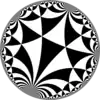 |
|||||
| Config. | V2.6.6 | V3.6.6 | V4.6.6 | V5.6.6 | V6.6.6 | V7.6.6 | V8.6.6 | V∞.6.6 | V12i.6.6 | V9i.6.6 | V6i.6.6 | |
| *n32 symmetry mutation of omnitruncated tilings: 6.8.2n | ||||||||||||
|---|---|---|---|---|---|---|---|---|---|---|---|---|
| Sym. *n43 [(n,4,3)] |
Spherical | Compact hyperbolic | Paraco. | |||||||||
| *243 [4,3] |
*343 [(3,4,3)] |
*443 [(4,4,3)] |
*543 [(5,4,3)] |
*643 [(6,4,3)] |
*743 [(7,4,3)] |
*843 [(8,4,3)] |
*∞43 [(∞,4,3)] | |||||
| Figures |  |
 |
 |
 |
 |
 |
 |
 | ||||
| Config. | 4.8.6 | 6.8.6 | 8.8.6 | 10.8.6 | 12.8.6 | 14.8.6 | 16.8.6 | ∞.8.6 | ||||
| Duals |  |
 |
 |
 |
 |
 |
 |
 | ||||
| Config. | V4.8.6 | V6.8.6 | V8.8.6 | V10.8.6 | V12.8.6 | V14.8.6 | V16.8.6 | V6.8.∞ | ||||
See also
References
- John H. Conway, Heidi Burgiel, Chaim Goodman-Strass, The Symmetries of Things 2008, ISBN 978-1-56881-220-5 (Chapter 19, The Hyperbolic Archimedean Tessellations)
- "Chapter 10: Regular honeycombs in hyperbolic space". The Beauty of Geometry: Twelve Essays. Dover Publications. 1999. ISBN 0-486-40919-8. LCCN 99035678.
External links
- Weisstein, Eric W. "Hyperbolic tiling". MathWorld.
- Weisstein, Eric W. "Poincaré hyperbolic disk". MathWorld.
- Hyperbolic and Spherical Tiling Gallery
- KaleidoTile 3: Educational software to create spherical, planar and hyperbolic tilings
- Hyperbolic Planar Tessellations, Don Hatch

